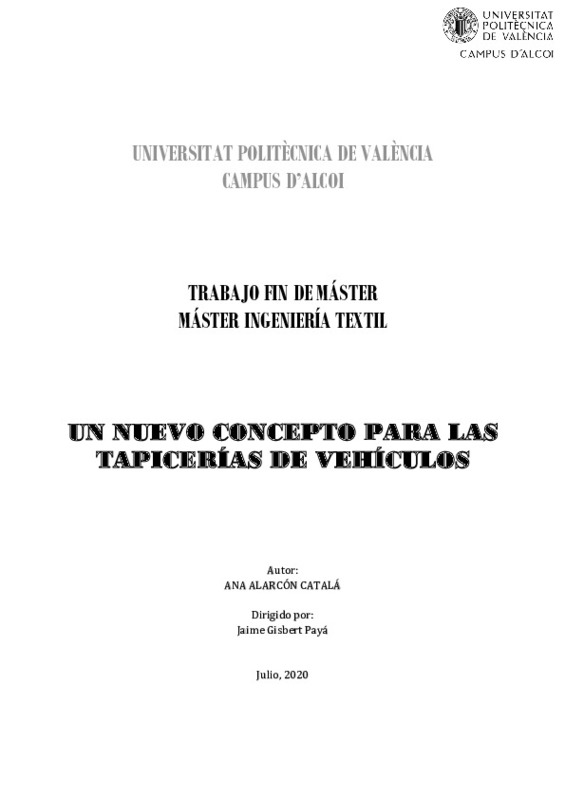|
Resumen:
|
[ES] En el presente proyecto, las tapicerías de automoción serán objeto de estudio para entenderlas como un nuevo concepto. Los asientos actuales llevan integrados las Tapicerías que están fabricadas, principalmente, con ...[+]
[ES] En el presente proyecto, las tapicerías de automoción serán objeto de estudio para entenderlas como un nuevo concepto. Los asientos actuales llevan integrados las Tapicerías que están fabricadas, principalmente, con Tejidos de calada 100% Poliéster, laminadas a una espuma de Poliuretano, mayoritariamente con tecnología foamizado a a la llama, que le proporciona un efecto de confort. Sin embargo, esta tecnología no es muy amigable con el medioambiente tanto por sus emisiones a la atmósfera durante el quemado de la espuma, como por su imposibilidad de separar ambos componentes (tejido y espuma) para su posterior reciclado. Es por este motivo, especialmente, por el que surge la idea del Proyecto, con el fin de mejorar las Tapicerías existentes y aportarles nuevas propiedades y funcionalidades.
En el presente proyecto se trabajará con Máquina Rectilínea para fabricar tejidos de punto 3D (knitted fabric), cuya estructura tendrá por sí sola mayor confort, sin necesidad de llevar lamida una espuma y manteniendo las propiedades mecánicas y químicas requeridas por las Normativas propias de cada constructor de vehículos (OEM's). Además, las Tapicerías ofrecerán una nueva característica, no existente hasta el momento. Se pretende que puedan ser fácilmente desmontables para su limpieza (lavado en lavadora), ya que se diseñarán sin costuras y confeccionadas de una sola pieza, fácil de quitar y poner, de ahí que reciban el nombre de Tejidos 3D.
Con el fin de demostrar si es factible llevar a cabo este nuevo concepto de Tapicerías, se confeccionan diferentes tejidos en cuanto a su composición, densidad, gramaje, título y ligamento y se someten a los ensayos más críticos que determinarán si son o no aptos para tal fin. El ensayo de Solidez a la luz establecerá que composición del hilo es la óptima. Una vez seleccionada la composición, se llevarán a cabo diferentes estructuras para elegir aquellas que alcancen los requisitos mínimos indicados en las Normas de ensayo frente a propiedades tales como Abrasión, Tracción y alargamiento, Deformación, Permeabilidad al aire y al vapor y Combustión, entre otras.
Por último, se estudiará el comportamiento que tienen los Tejidos de punto 3D frente a los tratamientos de limpieza. Para ello se ha estimado que un vehículo tiene de media una vida útil de 15 años, y que anualmente las Tapicerías serán sometidas a un ciclo de lavado en lavadora a 40ºC, según etiquetado de los símbolos de conservación. Por lo que se tomarán las medidas dimensionales antes y después de cada ciclo de lavado y secado, para asegurar que no encojan ni se deformen más de lo permitido en las Normativas.
[-]
[EN] In this project, automotive upholstery will be studied to understand it as a new concept. The current seats have upholstery integrated, which are mainly made of 100% Polyester openwork fabrics, laminated to a Polyurethane ...[+]
[EN] In this project, automotive upholstery will be studied to understand it as a new concept. The current seats have upholstery integrated, which are mainly made of 100% Polyester openwork fabrics, laminated to a Polyurethane foam, mostly with flame-foamed technology, which gives it a comfort effect. However, this technology is not very friendly to the environment, both for its emissions to the atmosphere during foam burning, and for its impossibility of separating both components (fabric and foam) for subsequent recycling. It is for this reason, especially, due to the emergence of the idea of ¿¿the Project, in order to improve the Upholstery specifically and provide new properties and functionalities.
In this project we will work with a Rectilinear Machine to manufacture 3D knitted fabrics (knitted fabric), whose structure will have greater comfort by itself, without the need to lick a foam and maintain the mechanical and chemical properties required by the Regulations of each vehicle manufacturer (OEM's). In addition, the Tapestries offer a new feature, it does not exist so far. It is intended that they can be easily removable for cleaning (machine wash), since it can be designed seamlessly and made in one piece, easy to remove and put on, hence they are called 3D Fabrics.
In order to demonstrate whether it is feasible to carry out this new concept of upholstery, different fabrics are made in terms of composition, density, weight, title and ligament, and the most critical tests can be obtained to determine whether or not they are suitable for such fin The Lightfastness test will establish the yarn composition is optimal. Once the composition is selected, carry out different structures to choose that meet the minimum requirements indicated in the Test Standards against properties such as Abrasion, Tensile and elongation, Deformation, Air and steam permeability and Combustion, among others.
Lastly, the behavior of 3D knitted fabrics compared to cleaning treatments will be studied. For this, it has been estimated that a vehicle has a useful life of 15 years, and that the upholstery will sometimes be two cycles of washing in a washing machine at 40ºC annually, according to the label of the conservation symbols. Therefore, the dimensional measurements will be taken before and after each washing and drying cycle, to ensure that it is not codified or deformed more than allowed in the Regulations.
[-]
|





![ZIP archive [ZIP]](/themes/UPV/images/zip.png)


